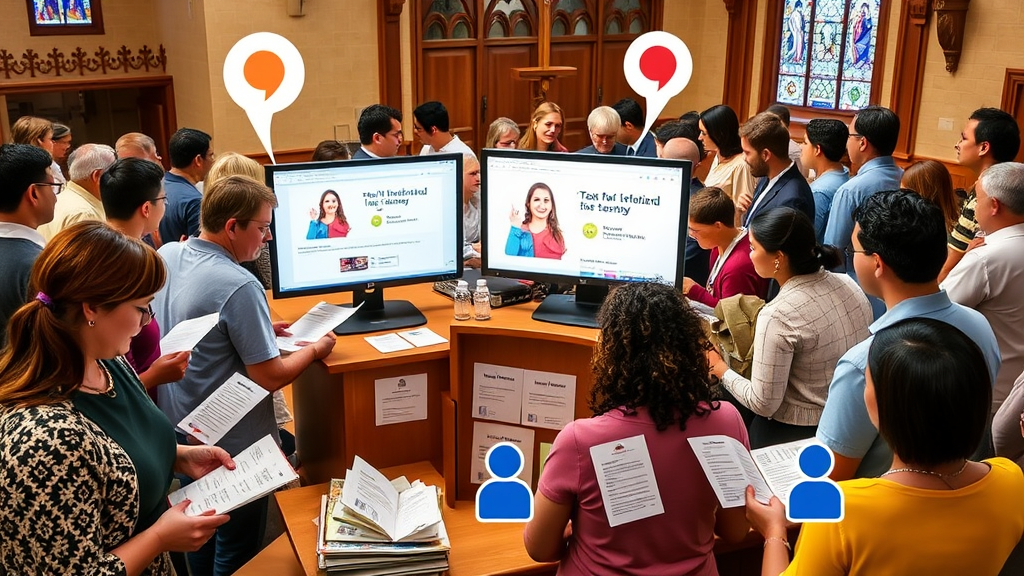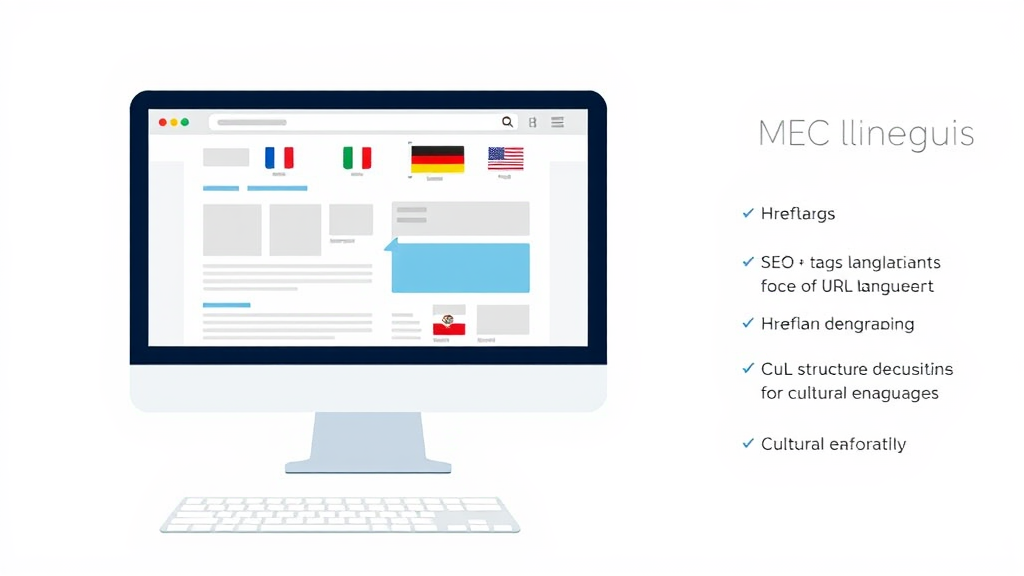Creating a multilingual website is essential for businesses and organizations looking to connect meaningfully with diverse audiences and foster inclusivity. By providing content in multiple languages, organizations can better communicate with non-English-speaking customers, build lasting connections, and enhance their global presence. This guide outlines the key steps for creating a successful multilingual website tailored for diverse congregations.
Key Takeaways
- Understanding Multilingual Websites: A multilingual website allows users to access content in multiple languages, facilitating communication with diverse audiences.
- Building the Website: Effective strategies involve using appropriate translation tools, ensuring SEO optimization, and considering cultural nuances in content presentation.
- Technology's Role: Utilizing advanced translation tools and engaging with community feedback can significantly improve the quality and effectiveness of multilingual content.
- Challenges: Adjustments in layout, currency, and cultural norms are crucial for creating a seamless user experience across different languages.
Ready to enhance your global presence? Learn more with ipsom.io.
Importance of a Multilingual Website
Creating a multilingual website is crucial for businesses that aim to engage with a diverse global audience. By offering content in multiple languages, organizations can build deeper connections with non-English-speaking customers. Effective communication fosters trust and enhances the overall experience, leading to increased customer satisfaction and loyalty.
Reaching Global Audiences
Speaking customers' native languages is a powerful tool. It establishes a connection that transcends cultural barriers, allowing businesses to resonate more deeply with their audience. Engaging non-English speaking communities requires a concerted effort to understand their unique needs and preferences, which ultimately builds lasting trust and rapport. According to a report by Common Sense Advisory, 75% of consumers prefer to buy products in their native language, underlining the significant advantage of multilingual strategies.
Case Studies and Examples
Successful multilingual websites provide a roadmap for effective implementation. Brands like Airbnb, Coca-Cola, and Canva offer robust examples of how diverse language content enhances user engagement and expands market reach. Furthermore, churches such as One Voice Fellowship demonstrate the impact of inclusive language approaches in worship, allowing for a genuine connection with attendees from various linguistic backgrounds. By examining these successful cases, organizations can identify key strategies for their own multilingual initiatives.
Key Steps in Building a Multilingual Website
Creating a multilingual website requires careful planning and execution across several key areas. Your approach should focus on ensuring effective communication, operational efficiency, and a user-friendly interface. By adhering to these steps, businesses can effectively engage diverse audiences and foster inclusivity.
Planning and Strategy Development
Start with a comprehensive assessment of your resources and the time required for implementation. Create a detailed plan that outlines the structure of your website and the content for each language. This may include defining the main languages to support based on your target audience. A well-organized plan simplifies the process and ensures that all stakeholders are aligned with the goals.
Translation Approaches
Choosing the right translation approach is vital. Focus on culturally relevant translations to capture linguistic nuances effectively. Consider using Advanced Machine Translation (MT) tools like DeepL for accuracy. These tools facilitate precise translations while reducing manual work. However, always supplement MT with human oversight to ensure that the content resonates with local audiences.
User-Friendly Language Options
Implementing clear and accessible language options on your website is key. A simple drop-down menu on the homepage can enhance user experience by allowing visitors to select their preferred language at any time. Additionally, ensure that your website design is responsive for mobile users, providing a consistent experience across all devices.
Content Optimization
SEO optimization plays a critical role in multilingual websites. Conduct thorough keyword research for each language version to ensure visibility in search results. Adapt your visual content by adjusting images, subtitles, and formatting to align with cultural preferences. These optimizations improve user engagement and strengthen your global reach, ultimately driving more traffic to your site.
Technical Considerations
Creating a multilingual website requires careful attention to technical details. Proper formatting for different languages is essential to ensure that all content is accessible and user-friendly. For example, languages that read from right to left, such as Arabic and Hebrew, require significant changes in layout. Adjusting the overall design will enhance the user experience for these language speakers.
In addition, localizing measurements, currencies, dates, and times is crucial for regional relevance. This means shifting from a one-size-fits-all approach to a tailored strategy that integrates local standards. For instance, using the metric system for many countries outside the U.S. can prevent confusion and create a more intuitive experience.
Utilizing Technology for Translations
Using technology effectively can streamline the translation process. One way to manage translations is through the use of properties files, particularly within frameworks like the Spring Framework. This method helps in organizing various language translations efficiently, allowing developers to update content without disrupting the user experience.
Incorporating dynamic values within translations is also vital. This means tailoring content to user interactions and preferences, ensuring that users feel recognized and valued. Dynamic translations can adapt based on location, preferences, or previous interactions, enhancing engagement and satisfaction.
Implementing these technical considerations will significantly boost the effectiveness and accessibility of your multilingual website.
Engaging with Community Feedback
Engaging with community feedback is essential for the success of a multilingual website. It allows organizations to tailor their content and services to the actual needs of their diverse congregations. By gathering input from users, churches can ensure that they are effectively meeting the expectations of various linguistic groups.
Implementing Feedback Mechanisms
Establishing feedback mechanisms enables churches to hear directly from congregation members about their language needs and preferences. This could include surveys, polls, or suggestion boxes. Real-time translations during worship can also enhance inclusivity, allowing for a smoother service experience. By actively seeking feedback, organizations can build a more connected and engaged community.
Resources for Future Use
Uploading translated manuscripts and content can provide accessible resources for church members. This includes downloadable PDFs and shared content on platforms like YouTube. Offering these resources helps broaden the reach of the organization, ensuring that non-English speaking members have the necessary tools to participate fully. Engaging with the community in this way fosters loyalty and strengthens relationships across linguistic divides.
Overcoming Challenges in Multilingual Content
Creating a multilingual website involves various challenges that must be addressed for effective communication. Key factors include:
- Understanding Cultural Nuances: Recognizing the unique values, communication styles, and preferences of different cultures.
- Customizing Content: Tailoring content to enhance user engagement and foster connection.
- Risks of Ignoring Differences: Failing to acknowledge cultural differences can lead to misunderstandings and weaken the intended message.
- Research and Feedback: Actively researching cultural contexts and incorporating feedback from community members greatly enhances content relevance.
Addressing Cultural Nuances
- Recognizing Varying Cultural Contexts: Critical for avoiding content that may be interpreted differently across cultures.
- Symbols and Colors: What is acceptable in one culture may be offensive in another.
- Localization vs. Translation: Your content should be localized to resonate with different audiences.
- Building Trust: Tailoring communication strategies to fit diverse backgrounds fosters deeper trust and receptivity.
- Engaging Local Experts: Utilizing local expertise and community feedback for precise content adjustments.
Technology and Scalability
Scaling your translation efforts effectively presents additional challenges:
- Initial Steps with Audio Translations: While a good starting point, this approach may need enhancement as your audience grows.
- Structured Approach Required: Implementing a systematic strategy is essential for scalability.
- Advanced Translation Tools: Leveraging modern technology to improve efficiency and accuracy.
- Collaboration with Human Editors: Ensures high-quality translations and adherence to context.
- Quality Assurance: Iterative feedback loops are critical for maintaining accuracy and conveying intended messages.
- Streamlining Processes: Utilizing technology can simplify scaling efforts, ensuring your multilingual content reaches its full potential.
Recommendations for Success
Continuous Improvement and Evaluation
Continuous improvement is key for a successful multilingual website. Organizations should conduct regular assessments to identify and solve emerging linguistic issues. Community feedback is crucial in this process. Engaging with users can reveal gaps in translations and highlight areas for enhancement. Utilizing tools like surveys or direct feedback channels can streamline this effort, ensuring content remains relevant and effective. Staying updated with advancements in translation technology is also essential for refining processes and ensuring consistent quality.
Collaboration and Networking
Collaboration plays a pivotal role in enhancing multilingual efforts. Sharing successes and challenges with other church leaders can foster a supportive environment where best practices are adopted and improved upon. Building a network that includes other organizations allows for the exchange of resources and insights. This can lead to more effective outreach through translated content. Cultivating global networks can amplify the impact of multilingual content. By working together, organizations can create a more inclusive environment that resonates with diverse congregations.
FAQ
How do I make my website multilingual?
To create a multilingual website, start by identifying the languages you want to include. Use an appropriate platform or content management system that supports multilingual functionality. Next, implement a language switcher for easy navigation. It is crucial to ensure each language variant has its own URL structure to enhance SEO. Consider local cultural nuances in content to strengthen engagement.
What is the best way to add a language switcher?
A language switcher allows users to select their preferred language easily. The best practices include placing it prominently at the top right corner of the website. Use flags or language codes (e.g., EN for English, ES for Spanish) for clarity. Ensure the switcher is responsive and functions seamlessly across all devices and page types.
What types of content should be translated for a multilingual site?
It's essential to translate core content like services, product descriptions, and customer support information. Additionally, translate any promotional materials, legal agreements, and user-generated content where applicable. Visual content such as videos should also be provided with subtitles or dubbing in multiple languages.
What are some SEO strategies specifically for multilingual websites?
For multilingual websites, perform keyword research for each language to target relevant phrases effectively. Utilize hreflang tags to inform search engines about the language and regional targeting of your pages. Ensure that URLs are properly structured to reflect language variations. Additionally, create localized content to improve search visibility.
How can I ensure quality in translations?
To ensure quality translations, employ professional translators who understand local dialects and cultural nuances. Use Translation Memory (TM) tools to maintain consistency across translations. After translation, have a review process with native speakers to catch any inaccuracies and improve the localization of content.
How should I determine which languages to include?
Research your audience demographics to identify their language preferences. Analyze website traffic data to see what languages customers are using. Prioritize languages that align with your target market and where you see the greatest potential for engagement and growth.
What tools can assist in creating a multilingual website?
Utilize CMS platforms with multilingual support like WordPress or Shopify. Translation tools such as DeepL, Google Translate, and AI localization platforms can streamline the process. Additionally, consider hiring plugins that facilitate language switchers, SEO functionalities, and localized content management.
How do I handle cultural differences in content presentation?
Cultural differences should inform your content presentation. Conduct thorough cultural research to understand preferences regarding imagery, color schemes, and messaging. Adjust visual and textual elements to resonate with local audiences. Use culturally appropriate metaphors and references for effective communication.
What role does community feedback play in multilingual website creation?
Community feedback plays a critical role in refining content and improving accessibility. Regularly solicit input from congregation members about their needs and preferences. Implement real-time feedback systems during services to assess translation effectiveness. This engagement fosters a sense of belonging and customizes the user experience.
How can technology improve the translation experience during services?
Technology can enhance translation during services through real-time interpretation tools and mobile apps that provide subtitles. Utilize streaming services that offer translation in various languages to reach diverse audience groups. Engaging with tools that facilitate live chat support in multiple languages can also enhance the experience for attendees.




